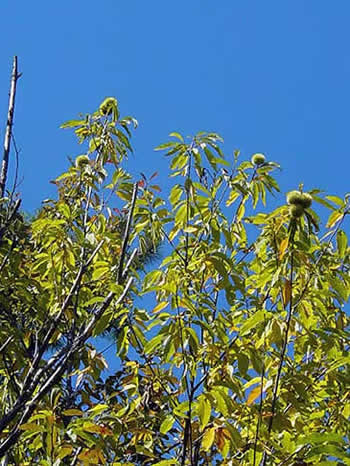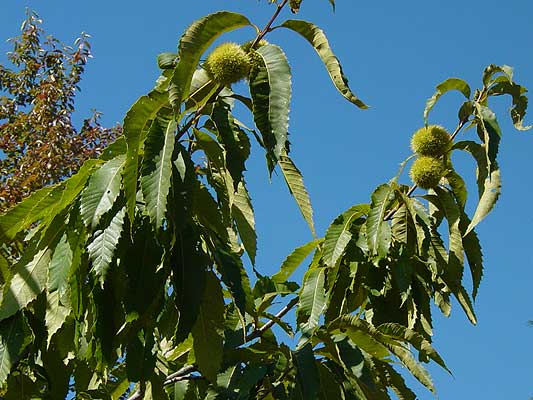Castanea dentata (American Chestnut) was once a native tree that grew from southern Maine across the Midwest to Michigan, down through Indiana and Illinois, and south to Alabama and Mississippi, and eastward into the Appalachians. The American Chestnut was cultivated in 1800 and was once considered to be the queen of the eastern American forest. With massive, wide-spreading branches and a deep broad-rounded crown, the American Chestnut was known to reach a height of 100 feet. Its greatest size was reached in the southern Appalachains. Chestnuts grew in the eastern forests along with several species of oak, hickory, maple, and birch. It was commonly found on mountains, hills, and slopes in gravelly or rocky, well-drained glacial soils.
From Plants for a Future
Edible Uses
Edible Parts: Seed.
Edible Uses: Chocolate; Coffee; Oil.
Seed - raw or cooked. Rather on the small side, but these are the sweetest seeds of any species in this genus. The seed contains about 7% fat, 11% protein. It can be dried, ground into powder and then be added to cereals when making bread, cakes etc. A delicious oil can be extracted from the seed by crushing the nuts, boiling them in water and then skimming off the oil as it comes to the surface. It can be used as a topping for various puddings. The roasted nut can be used as a coffee substitute and a chocolate substitute can also be made from it (no further details).
Medicinal Uses
Astringent; Expectorant.
A warm water infusion of the leaves has been used to calm the respiratory nerves and promote expectoration. The infusion has also been used in the treatment of whooping cough but modern opinion is that the leaves are no more than a mild astringent.
Other Uses
Dye; Tannin; Wood.
The bark is a good source of tannin. The dried leaves contain 9% tannin. The wood and the seed husks also contain tannin. The husks contain 10 - 13% tannin. A brown dye is obtained from the bark. Wood - soft, not strong, light, very durable, liable to warp. It weighs 28lb per cubic foot. Easy to split, it is used for making cheap furniture, fence posts, in construction etc.

The flowers of the American Chestnut appeared in June- July, producing a spectacular display of creamy-yellow blossoms and were strongly scented. The flowers were similar to those of the Chinese Chestnut, Castanea mollissima. The fruits ripened and dropped after the first frost. The fruit was much smaller and more flavorful than its Asian counterpart. The nuts of the American Chestnut were large, sweet, and highly desired by people, deer, squirrels, and chipmunks. In the days before the Chestnut blight, the tree reproduced abundantly by seeds and sprouts, had few insect enemies, and competed well with the other trees of the forest. Today, the American Chestnut is known only in memory because the young American chestnut trees rarely survive long enough to produce flowers and fruits.
 American Chestnut
American Chestnut